- News
- Reviews
- Bikes
- Components
- Bar tape & grips
- Bottom brackets
- Brake & gear cables
- Brake & STI levers
- Brake pads & spares
- Brakes
- Cassettes & freewheels
- Chains
- Chainsets & chainrings
- Derailleurs - front
- Derailleurs - rear
- Forks
- Gear levers & shifters
- Groupsets
- Handlebars & extensions
- Headsets
- Hubs
- Inner tubes
- Pedals
- Quick releases & skewers
- Saddles
- Seatposts
- Stems
- Wheels
- Tyres
- Tubeless valves
- Accessories
- Accessories - misc
- Computer mounts
- Bags
- Bar ends
- Bike bags & cases
- Bottle cages
- Bottles
- Cameras
- Car racks
- Child seats
- Computers
- Glasses
- GPS units
- Helmets
- Lights - front
- Lights - rear
- Lights - sets
- Locks
- Mirrors
- Mudguards
- Racks
- Pumps & CO2 inflators
- Puncture kits
- Reflectives
- Smart watches
- Stands and racks
- Trailers
- Clothing
- Health, fitness and nutrition
- Tools and workshop
- Miscellaneous
- Buyers Guides
- Features
- Forum
- Recommends
- Podcast
review
£2,999.99
VERDICT:
Great ride feel and integrated Climb technology make this an impressive debut for Wahoo's standalone bike
Hugely adjustable
Effective and configurable virtual gearing
Smooth, accurate and predictable resistance
Tilt mechanism adds another dimension
Expensive
Digital gear readout in a daft place
Steering buttons too easy to press by accident
ERG mode algorithms need a tweak
ERG smoothing a bit glitchy
Weight:
42,000g
Contact:
At road.cc every product is thoroughly tested for as long as it takes to get a proper insight into how well it works. Our reviewers are experienced cyclists that we trust to be objective. While we strive to ensure that opinions expressed are backed up by facts, reviews are by their nature an informed opinion, not a definitive verdict. We don't intentionally try to break anything (except locks) but we do try to look for weak points in any design. The overall score is not just an average of the other scores: it reflects both a product's function and value – with value determined by how a product compares with items of similar spec, quality, and price.
What the road.cc scores meanGood scores are more common than bad, because fortunately good products are more common than bad.
- Exceptional
- Excellent
- Very Good
- Good
- Quite good
- Average
- Not so good
- Poor
- Bad
- Appalling
Wahoo's Kickr Bike is certainly an impressive bit of kit, with one of the nicest ride feels of any indoor trainer I've tried. It's hugely configurable and incorporates Wahoo's angle-adjusting Climb tech into a static bike, which is impressive. It's not without its issues, though, some which will no doubt be ironed out with updates and some which definitely won't be, unless they send you new bits in the post.
Construction and setup
The Kickr Bike comes in an intimidatingly large box, but it's surprisingly easy to put together. It's heavy, for sure, and really a job for two people, but the actual construction is simple. It's just a case of screwing the legs on and slotting in the bar and seat, plugging in the shifters and tightening everything up. It only took about 20 minutes.
> Find your nearest dealer here
Like all gym-style static bikes the Kickr is very adjustable. You can raise and lower the whole bike with a big lever on the seat tube, and the reach is adjustable at both the handlebar and the seat. I was a bit worried that the stem and seatpost adjustments – which are standard round tube profiles instead of chunky square-section beams – would feel a bit flimsy on a static bike, but I've had no issues with them at all.
The adjustability means you can get your reach right, but you can also experiment with moving your position forwards and backwards relative to the pedals. The seat and bar height are also independently adjustable, and the crank has a clever five-hole system that allows you to simply change your crank length from 165mm to 175mm in 2.5mm increments. Basically you can get it to exactly match your bike, and you can also try tweaks to your position that you can migrate to your real-world setup if they work for you.
If you've had a professional bike fit you can feed the numbers from that into the Wahoo app and it'll tell you where to set the sliders. The second option is to take a picture of your bike and match up various bits; given the wheelbase dimension, the app tries to work out your geometry and match that.
I tried it, with mixed results: the app got my saddle height spot on but the bike dimensions were a bit big – reach was too long, and saddle setback was too big.
The third way is to just enter your height and inseam, and what sort of position you're looking for, and the app will suggest some settings to fit you. I found the fit from that process to be generally better; the seat height was a bit too much – I have mine dropped about about 1cm due to historical back issues, and the app wouldn't know that – but other than that it was pretty much bang on in terms of feel.
The ride
Whereas the Tacx team already had a resistance unit that was capable of replicating gear changes and freewheeling downhills for their Neo Bike, Wahoo has a new unit sitting in this bike. It's a combination of a flywheel and motor, unlike the Neo which just uses the motor to emulate a flywheel.
So there's a 6kg flywheel and a pretty beefy-looking motor that Wahoo claims can offer 2,200W of resistance, not that I'm ever going to know. Like the Neo Bike, you can use the associated app to customise the gears to match your bike; all the road/gravel groupsets from SRAM, Shimano and Campagnolo are supported and you can use custom values if you want something else.
You can store multiple profiles in the app, which include both the bike's physical settings and its virtual gears. So if you have a road bike and a TT bike, you can have all the dimensions and gearing to hand. Which is nice. You can set the buttons on the levers to emulate your preferred setup too. Which is also nice.
Braking is supported, which isn't a big thing now but might well prove to be a couple of years down the line, when Zwift starts pitching you off the side of the Alpe if you're going too fast on the descent. Steering isn't, in the sense of the handlebar moving, but there are steering buttons on the inside of each shift lever. They don't actually work in Zwift as yet, though, and they're also directly where I place my thumb on the hoods, so I was pressing them all the time whether I meant to or not. That's not an issue when I'm not using them but it's bound to be when I eventually do.
> 13 of the best indoor cycling apps
The virtual gearing is very effective. Change up or down the block and there's an instant response from the bike as it clicks the resistance up and down. Looking at the power trace on Zwift you can see the jumps in power as the changes hit.
Like the Kickr direct drive trainer, the Kickr Bike has ERG smoothing as an option, which smooths out your power graph. I suggest you turn this off: I found that it made the power output from the bike pretty sticky, so that the bike would hold a certain power even when I backed off the pedals. Changing gear would usually wake it up. It works fine with ERG smoothing switched off, over both Bluetooth and ANT+, and the smoothing is pretty pointless anyway. It'd be better to just bin it, really. I can't really see the point of it.
> Buyer’s Guide: 14 of the best turbo trainers
Directly comparing the Kickr Bike to the Neo Bike, I'd say that the virtual gearing was as effective, and overall the bike has a slightly different feel. The Kickr feels a bit smoother, and the Neo feels a bit more responsive. Neither is better, really, but one might suit you over the other. Of the two, I preferred the Kickr.
Looking at my numbers from racing it's not like the Kickr was giving me extra watts or anything, but the overall feel made racing a bit easier. I think it's mostly to do with how the bike responds to harder efforts, and holds a higher power a bit more smoothly. When you're struggling up a rise, late into the race and well into the red, it just seems a bit easier to keep the pedals turning.
One thing I certainly didn't prefer is the placing of the gear readout. On the Neo Bike it's centre stage in front of you, and on the Kickr Bike it's tucked away down below the top tube. It's hard to see at the best of times, and if you're adding a sweat catcher – and I definitely am adding a sweat catcher to something I'm going to sweat all over that costs three grand – it's obscured, and you need to look round the sweat catcher to see what gear you're in. That needs a rethink.
The Neo bike (right pic) wins easily here: the display is great, and you also get a nice tray for your phone. You'll need some kind of mount for the Kickr. I just use a Garmin out-front mount and an old case with a 3D-printed garmin mount glued to the back, which works very well. There's a USB port under the stem so you can charge as you go.
The Kickr Bike does one thing that the other smart bikes don't do: it includes a tilt mechanism that physically simulates gradient. It can be set to automatically follow gradient if your preferred cycling app supports that, or it can be manually adjusted using the up/down buttons on top of the left-hand lever. You can switch between the two modes using a button on the side of the gear indicator box.
And it's very effective. It has a big range – from 20% to -15% – although your bike setup might curtail that a little bit at either end. The bike pivots about the seat tube, and the motor driving the motion is quiet and efficient. It certainly adds an extra dimension to the climbs and descents, and the whole experience is a bit more immersive as a result. It's also a physical cue to what's going on if you're not paying close attention to the screen.
I found that I liked it, and I was also glad of the fact that you can set the bike at about 8% incline after a race or hard interval session which gives you a nice sat-up position for cooling off.
I've used the Kickr Bike for about 1,500km of indoor riding, including a daft 500km charity ride that took 22 hours in total, and I have to say I'm impressed. It's a solid platform, the ride feel is excellent, the virtual gears are sufficiently good that you never really think about them, and the whole thing feels like a quality piece of kit.
The only real issue I've had during riding is that the central height mechanism – the one that adjusts the height of the bike as a whole – is prone to backing off slightly after a while, and when it does that it starts to creak. When it does it's a case of undoing the lever, giving it a bit of a jiggle and tightening everything up again, which isn't really something you can do mid-ride and is also something you (I) immediately forget to do as soon as I stop.
Accuracy
OK, let's have a look at some numbers shall we? Here's a plot of a race on Zwift, comparing the Kickr Bike (purple) with a set of Favero Assioma power pedals (blue). Normally I'd use my Garmin Vector 2 pedals but there's not enough of a gap between the crank and chain case on the Kickr Bike to fit them.
Anyway, it all looks pretty good. The pedals are reading slightly high compared to the bike, about 3% overall. There's no obvious discrepancy or dropouts over and above that. If we zoom in a bit to the first five minutes or so of the race:
You can see that the gap between the Kickr power trace and the Assioma pedals isn't necessarily exactly consistent, but they're tracking each other very well. At the start there's the usual ramp up to the start and a few short, hard efforts to make sure I'm keeping contact with the front group (don't worry, I lost them on the first proper climb). Then things ease off a bit before a harder section up the climb after the sprint and through the esses.
If I was looking at either power trace independently I'd be happy that it was a pretty accurate representation of what I was doing. In terms of absolute numbers I'd be more inclined to believe the Kickr; the pedals seem to be reading a bit high in my opinion, given what I know of my fitness and what other trainers have said my numbers are. Wahoo claims a +/- 1% accuracy, and since there's no calibration you're going to need it to be spot on.
Cadence-wise, it's a similar story: both plots are entirely believable, although again there's a minor discrepancy of about 1rpm between them. Which is correct? I've no idea, but unless you're aware enough of your cadence to know the difference between 90rpm and 91rpm it's not going to make a whole bunch of difference.
Now let's check out ERG mode and head over to a short structured session:
Again the pedal plot is on top of the bike, although interestingly they seem to drift apart a bit between the start of the session and the end; I'm not entirely sure what caused that in this instance as both bike and pedals were warmed up. If we look at three of the minute intervals:
We can see that the first is the one where the Kickr struggles most to maintain an accurate power, with the next one better and the last one the best. They were all ridden differently: the first interval is at my normal riding cadence (85rpm), the second spinning faster (100rpm) and the last one out of the saddle at low cadence (55rpm).
In the first interval the target power was 350W and the reported power is up to 50W either side of that. It's quite a discrepancy, and it's not ideal that the worst results are using the bike at normal riding cadences. By comparison, the fluctuation when standing was less than half of that on a higher target power, which is where I'd like it to be for every interval. Especially when I'm shelling out three grand.
The short sprints at the end (10 seconds at 630W, 790W and 950W) show that the Kickr is very responsive, but tends to overestimate the resistance needed for the interval, and then back off. Each of the intervals had a maximum effort of at least 50W over the requirement, with the middle interval topping out at 916W when the target was 790W. It's not unusual to see this ramp-up-then-back-off profile with smart trainers on ERG mode but I'd like to see Wahoo do some work with the algorithms here to make it less aggressive.
Overall
There's no getting away from the fact that at £3,000 the Kickr Bike is an expensive bit of kit. You can pay plenty more of course – SRM's static bike is €5,000 – but realistically this bike is mostly going to be competing with the Tacx Neo Bike Smart, the Stages SB20 and the new Wattbike Atom now it's been upgraded to an electromagnetic resistance unit. Aside from the fact that the Kickr includes the Climb mechanism, they're all pretty directly comparable: motor resistance, virtual gears, adjustable setup, gym bike quality.
Of those three, the only one I've actually tested is the Neo Bike, which is excellent; there's a new Wattbike coming in for review soon. All three are cheaper than the Kickr too: the Stages bike is a bit cheaper, and the other two are significantly cheaper. In the case of the Wattbike, over a grand cheaper. That's a pretty big saving.
Directly comparing the two bikes I've ridden up until this point – the Kickr and the Neo – I'd say that the ride experience of the Kickr is slightly better, and the user experience of the Neo edges it. So really, there's not a lot to choose between them in my opinion, and you certainly won't be disappointed with either. If the extra immersive dimension of the bike moving underneath you is important to you then the Kickr will be your choice. To be honest, it'll need to be pretty important to justify the difference in price between the two. If it was my money, right now I'd opt for the Neo; I'm looking forward to seeing what the new Atom has to offer.
Verdict
Great ride feel and integrated Climb technology make this an impressive debut for Wahoo's standalone bike
road.cc test report
Make and model: Wahoo Kickr Bike
Size tested: One size
Tell us what the product is for and who it's aimed at. What do the manufacturers say about it? How does that compare to your own feelings about it?
Wahoo says:
Ride real with the KICKR smart bike
KICKR BIKE offers unprecedented innovations such as integrated grade changes, customizable gearing, and simulated shifting to create the most powerful, personalized, and realistic indoor training experience.
Using KICKR's legendary flywheel technology, the KICKR BIKE creates unparalleled responsiveness and power accuracy of +/- 1%. Real-time grade changes will match ascents of up to 20% and descents of -15% while allowing you to maintain speed and truly replicate the sensation of riding outdoors. Its robust steel and aluminum construction will withstand the hardest rides - even if your legs don't.
The Wahoo Fitness app will guide you through an easy set-up of the five points of adjustability on the KICKR BIKE. Choose from either using professional bike fit measurements, taking a photo to measure your bike, or entering body measurements to personalize the fit to the exact geometry of your outdoor bike. The KICKR BIKE can also be customized with your own handlebars, pedals, and saddle.
The virtual shifting technology of the KICKR BIKE is programmable to match the exact gear ratios, number of speeds, cassette tooth count, and group set from the leading manufacturers - SRAM, Shimano, and Campagnolo. A digital display clearly communicates both gearing and grade so you always know where you are during every stage of the ride.
KICKR BIKE seamlessly integrates with other Wahoo products and easily pairs to your ELEMNT GPS bike computer, smartphone, tablet, or PC. As with all Wahoo smart trainers, KICKR BIKE is compatible with the most popular training apps such as The Sufferfest, Zwift, TrainerRoad and more! KICKR BIKE is not only a smart bike - it's a training machine that blurs the line between virtual and reality.
Tell us some more about the technical aspects of the product?
Wahoo lists:
Part Number: WFBIKE1
Shipping Dimensions: 54" x 14" x 35" (1350 x 340 x 880 mm)
Product Weight: 93 lbs (42 kilograms)
Drivetrain: Belt Drive
Resistance Type: Electromagnetic and enhanced motor
Power Accuracy: +/- 1%
Wireless Software Updates: Yes, via the Wahoo Fitness app
Connectivity: ANT+ FEC and Bluetooth
Device Compatibility: iOS, Android, PC (Mac and Windows)
User Height Range: 5 feet (152 cm) to 6 feet 4 inches (193 cm)
Max User Weight: 250lbs
Power Requirements: 100-240V, 50/60 Hz, 2.5A Max
Flywheel Weight: 13 lbs plus enhanced motor
Crank Arm Lengths: 165, 167.5, 170, 172.5, and 175
Maximum Simulated Grade: 20%
Minimum Simulated Grade: -15%
Maximum Power Output: 2200 Watts
FEATURES
OPTIMIZED FLYWHEEL TECHNOLOGY
KICKR BIKE has a unique combination of a 13lb flywheel and enhanced motor that offer unrivaled accuracy, responsiveness, and realism while training indoors.
VIRTUALLY SILENT OPERATION
The balanced, belt driven motor on KICKR BIKE combines years of engineering knowledge to create a virtually silent riding experience.
CONTROLLED RESISTANCE
When connected to your smartphone, tablet or computer, KICKR BIKE automatically sets your resistance via your favorite app or software
REALISTIC RIDE FEEL
The KICKR BIKE flywheel and enhanced motor is an innovative technology that emulates the power and inertia experienced during outdoor riding. It provides the most realistic ride feel especially when using virtual riding/training platforms like Zwift, The Sufferfest, and TrainerRoad.
REAL-TIME PHYSICAL GRADE CHANGES
The KICKR BIKE simulates grade changes in real-time by not only providing changes in resistance, but also physically raising and lowering the bike to match ascents up to 20% and decents as steep as -15%.
+/- 1% POWER ACCURACY
Proven power accuracy that provides our most accurate power measurement of +/- 1% and generates up to 2200W of resistance.
CALIBRATION FREE
KICKR BIKE continuously offers accurate power and doesn't require a calibration procedure.
EASY APP SET-UP
Our simple and intuitive Wahoo Fitness app offers guided instructions on how to set-up the KICKR BIKE and personalize the fit to mirror the geometry of your outdoor bike using 3 options - professional fit, measure my bike, and measure my body.
5 POINTS OF ADJUSTABILE FIT
Adjust the fit of the KICKR BIKE with easy access quick-release levers across 5 points - stack, reach, setback, saddle height, and frame height.
ADJUSTABLE CRANK ARM
KICKR BIKE supports 165, 167.5, 170, 172.5 and 175mm crank lengths
PROGRAMMABLE VIRTUAL SHIFTING
Customize the KICKR BIKE shifting controls to match shifters from the leading manufacturers - SRAM, Shimano, and Campagnolo
PROGRAMMABLE GEARING
Replicate your outdoor bike down to the exact gearing configuration by selecting the number of speeds and cassette tooth count.
VIRTUAL BRAKING
A combined electromagnetic flywheel and motor allow for quick braking to create a precise feel while shifting and while riding downhill.
CUSTOMIZABLE KIT
Customize the KICKR BIKE with your favorite saddle, bars, and pedals to dial in the perfect setup.
ANT+ AND BLUETOOTH CONNECTIVITY
ANT+ and Bluetooth capabilities allow it to connect to both smartphones and GPS devices simultaneously or separately.
MULTIPLE SIMULTANEOUS BLUETOOTH CONNECTIONS
KICKR BIKE supports up to three simultaneous Bluetooth connections for a trouble-tree start to your workout
MANUAL CONTROL OF GRADE CHANGES
The control unit on the KICKR BIKE contains an lock/unlock button, which allows you to turn on and off the physical tilt control of an app while still allowing the app to control the resistence.
DIGITAL LED DISPLAY
LED display indicates gear selection and grade percentage, so you can get information with just a quick glance during your ride.
PROFESSIONAL GRADE DURABILITY
Robust aluminum and steel construction ensures the KICKR BIKE will withstand years of heavy abuse.
MEASURES SPEED, DISTANCE, POWER, AND CADENCE
Get these vital cycling metrics on your indoor ride on the KICKR BIKE without connecting any extra sensors
KICKR HEADWIND COMPATIBLE
KICKR HEADWIND brings innovative climate control to your indoor training experience. Pair to your KICKR BIKE and as your speed or heart rate increases, so will the fan speed.
ELEMNT BIKE COMPUTER COMPATIBLE
Connect the KICKR BIKE to any ELEMNT Bike Computer to relive rides or perform planned workouts.
THIRD PARTY APP COMPATIBILITY
Works with popular training apps, including Zwift, The Sufferfest, and TrainerRoad. For more details on which apps are compatible with the KICKR BIKE, download our in-depth KICKR app comparison chart.
BONUS FEATURE! FREE TRIALS FROM OUR FAVORITE APP PARTNERS
When you register your KICKR in the Wahoo Fitness app, you'll receive these awesome offers from our partners:
30 Days FREE of Zwift for new members
60 Days FREE of Strava Summit for new Strava members
30 Days FREE of TrainerRoad for new users
60 Days FREE of The Sufferfest Training Center for new Sufferfest members
10% off annual subscription of Fulgaz for new subscribers
30 Days FREE of Rouvy for new premium subscribers
Rate the product for quality of construction:
9/10
Very nicely built.
Rate the product for performance:
8/10
Great ride feel. Some creaking from main up/down adjustment. Display in an odd place. Steering buttons too easy to press by accident.
Rate the product for durability:
8/10
No issues during testing, I'd recommend a sweat catcher!
Rate the product for weight (if applicable)
9/10
Reassuringly heavy.
Rate the product for comfort (if applicable)
8/10
Very configurable, easy to get the correct position.
Rate the product for value:
4/10
More expensive than its direct competitors.
Tell us how the product performed overall when used for its designed purpose
Very well overall: the ride experience is excellent. Some niggles with design though, and ERG needs a little bit of tweaking.
Tell us what you particularly liked about the product
Hugely adjustable and configurable, great ride feel.
Tell us what you particularly disliked about the product
Display in odd place, a bit creaky at times, ERG needs a tweak.
How does the price compare to that of similar products in the market, including ones recently tested on road.cc?
It's expensive compared to the Tacx Neo Bike and new Wattbike Atom; similar to the Stages SB20.
Did you enjoy using the product? Yes
Would you consider buying the product? No
Would you recommend the product to a friend? Yes
Use this box to explain your overall score
Overall it's very good: great ride feel, the Climb integration adds another dimension. I feel there are more niggles overall than with the Neo Bike, though, and it's a lot more expensive.
About the tester
Age: 47
I usually ride: whatever I'm testing... My best bike is: Kinesis Tripster ATR, Merida Scultura, Dward Design fixed
I've been riding for: Over 20 years I ride: Every day I would class myself as: Experienced
I regularly do the following types of riding: road racing, time trialling, cyclo cross, commuting, touring, club rides, sportives, general fitness riding, fixed/singlespeed, mtb, Mountain Bike Bog Snorkelling, track
Dave is a founding father of road.cc, having previously worked on Cycling Plus and What Mountain Bike magazines back in the day. He also writes about e-bikes for our sister publication ebiketips. He's won three mountain bike bog snorkelling World Championships, and races at the back of the third cats.
Latest Comments
- Aluminium can 5 hours 10 min ago
So there's electronics and computers and motors for gear changes and pumping up or deflating tyres. Why not just motorise the whole bike and be...
- ktache 7 hours 7 min ago
Quest are showing the Paris Roubaix highlights at 11 both days.
- chrisonabike 7 hours 51 min ago
Pretty sure a lot of that "more space for motor vehicles" was because fewer motor vehicles (also marginally "smaller motor vehicles")....
- David9694 8 hours 38 min ago
I get the impression he represented himself, came over as a bit of an ass and received a ban, when a lawyer might have got him spared that.
- Rendel Harris 8 hours 41 min ago
Well if you ever get the chance and you feel yourself flagging give me a shout, happy to put in a shift.
- Laz 8 hours 49 min ago
OMG- that's so self centred....what about the brotherhood and sisterhood of enjoying a ride and sharing a happy wave with a fellow rider out...
- thax1 9 hours 16 min ago
Cycliq certainly seemed to let a lot of people down in the early days. I held off until the 12 Sport came out, but have been impressed....
- ktache 9 hours 18 min ago
My better half seems to like giving me pressies of Rapha clothing. I am wearing their casual hoodie right now, and very nice it is too. First off...
- thax1 9 hours 28 min ago
Push on through foot numbness and you then arrive at agonising foot cramp....
- Destroyer666 10 hours 5 min ago
Oh dear, to your own lack of understanding. I was not referring to your vague generalisation of "people", I was referring to a particular...



























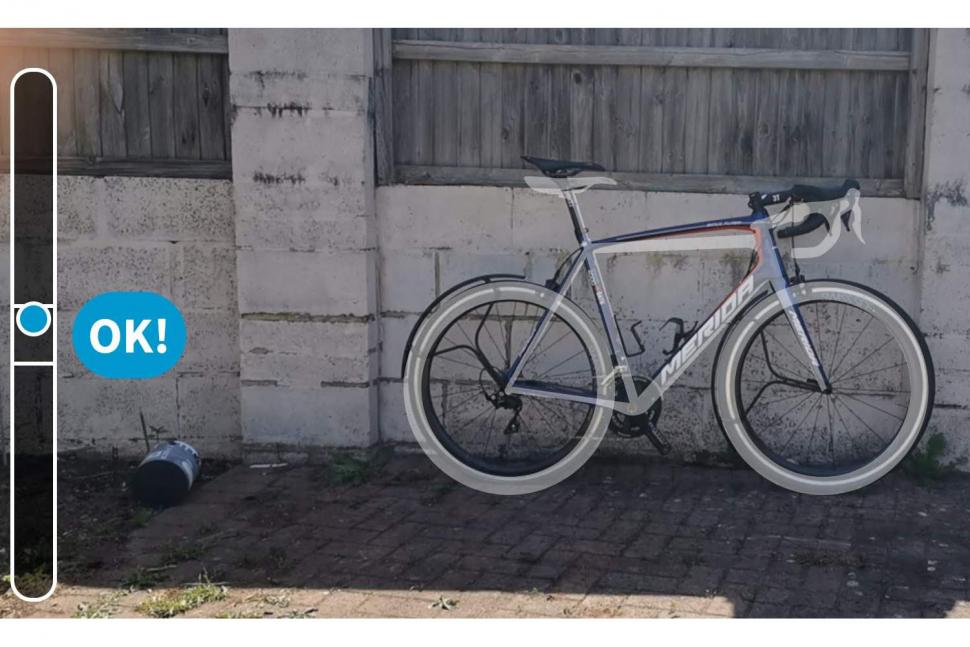

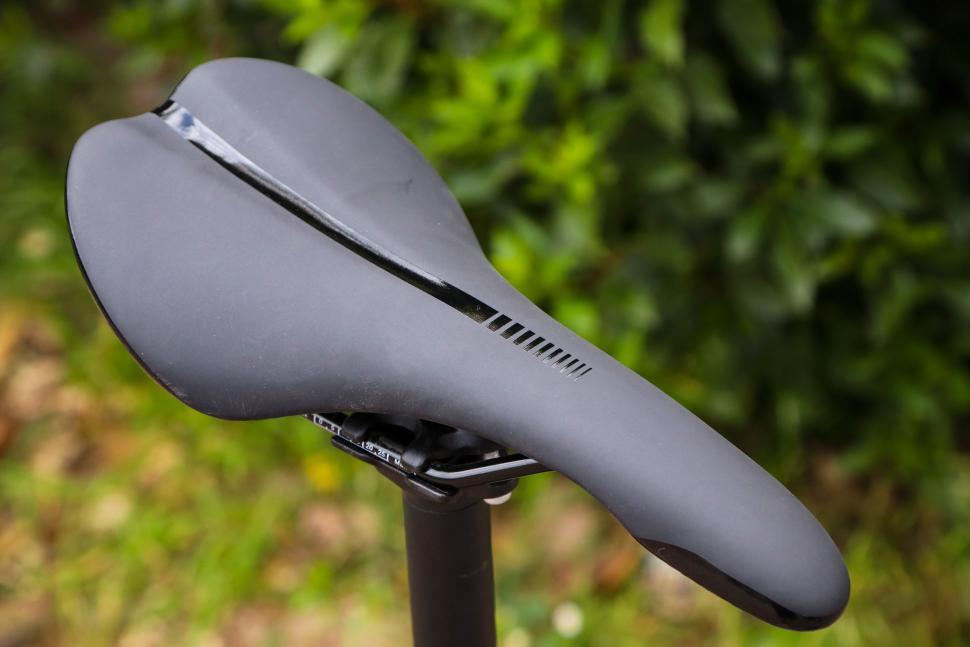
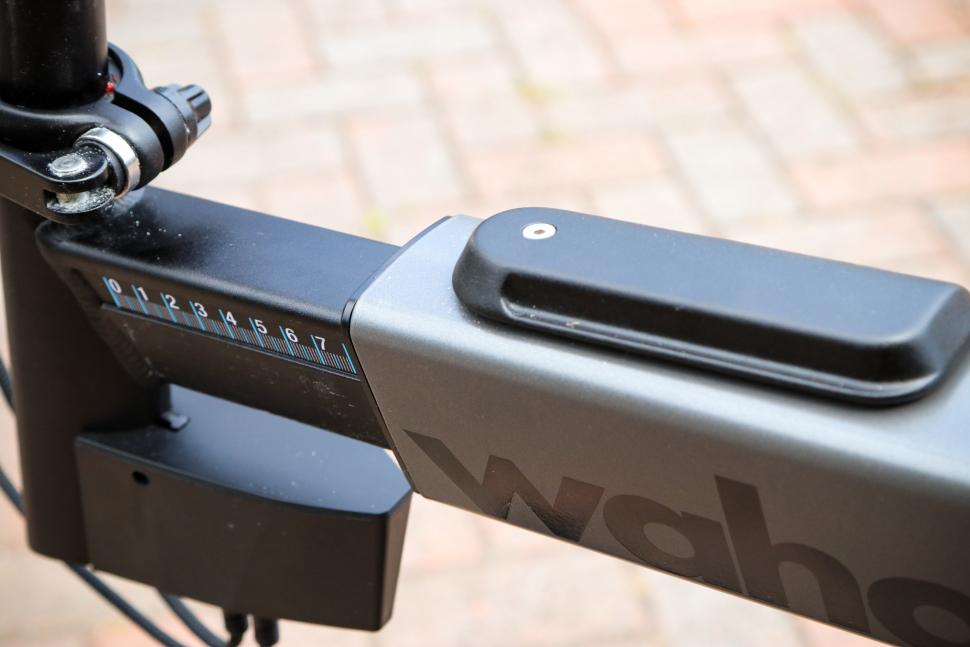
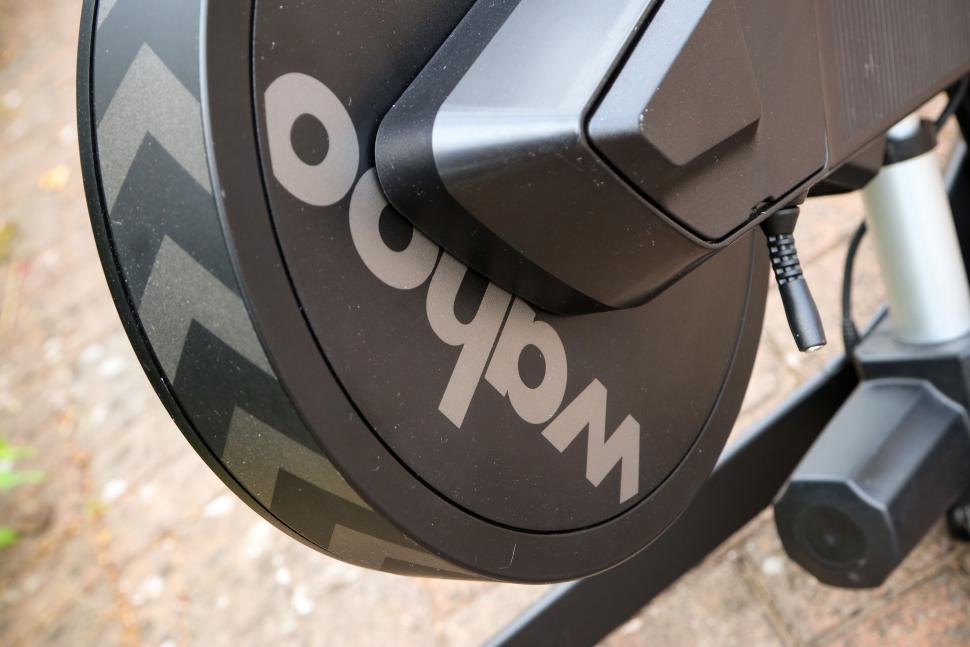
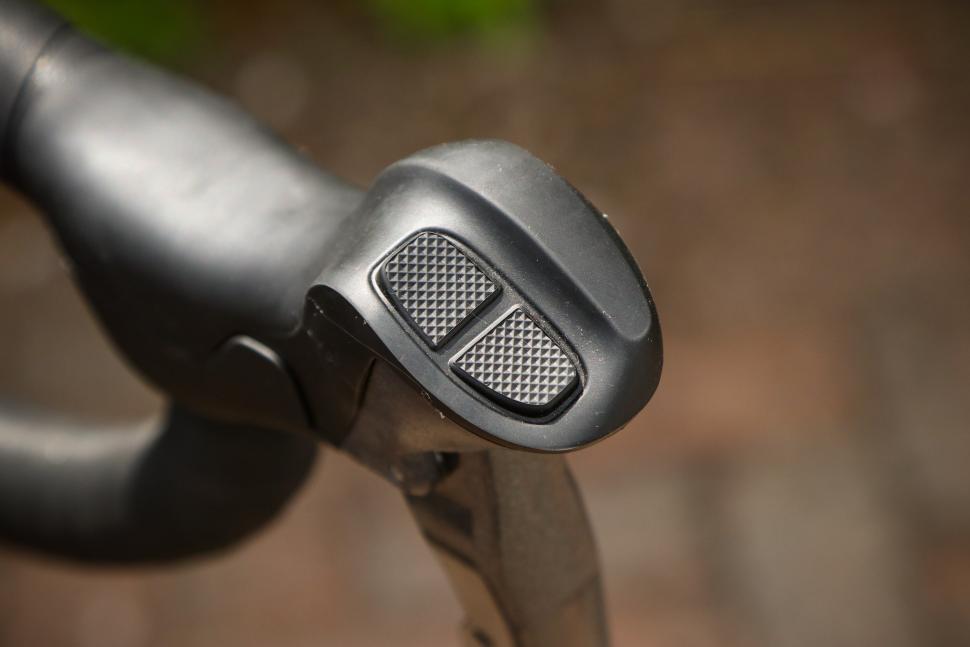


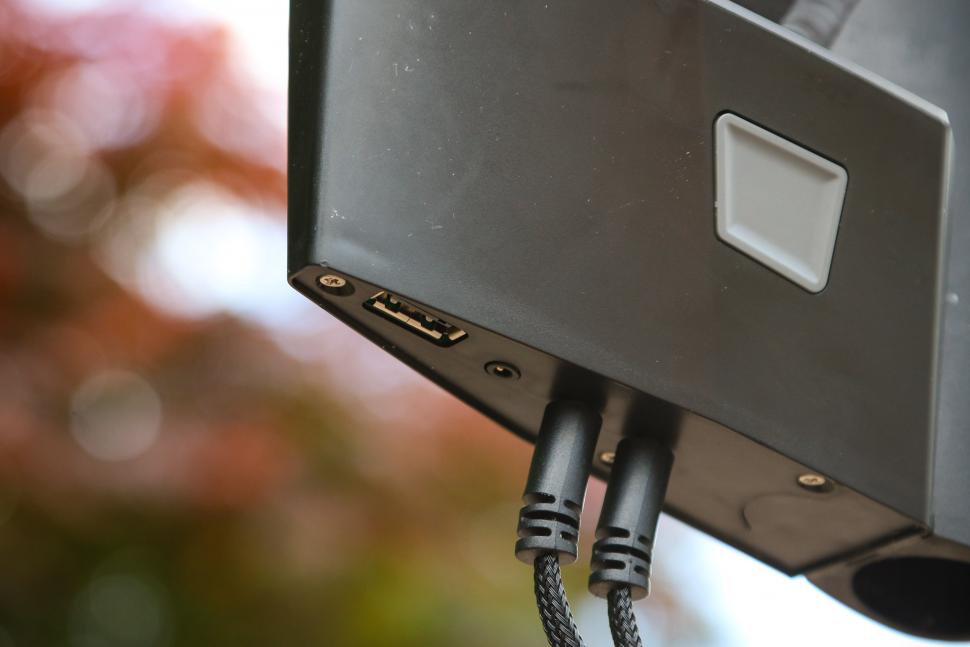
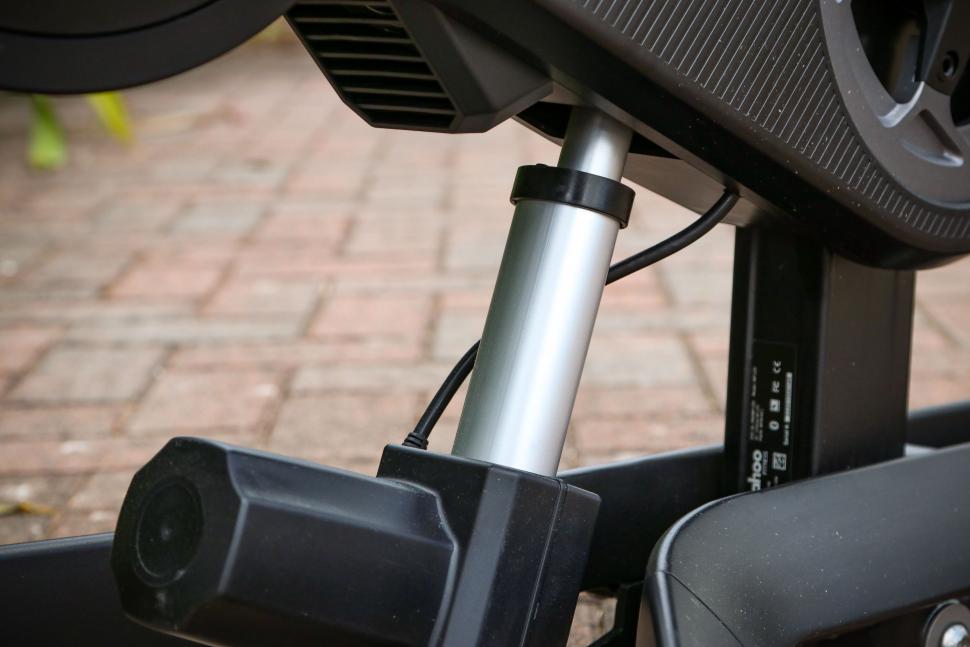


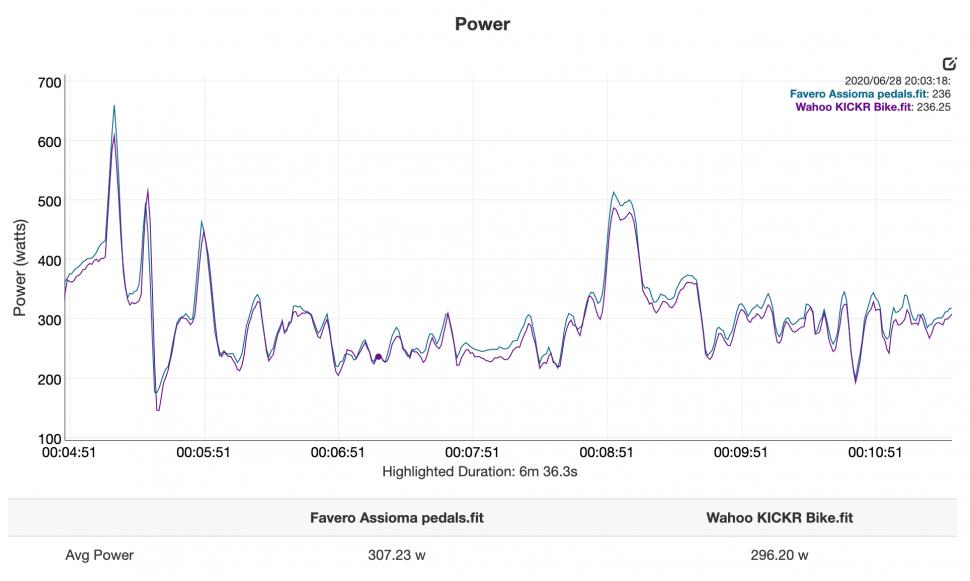



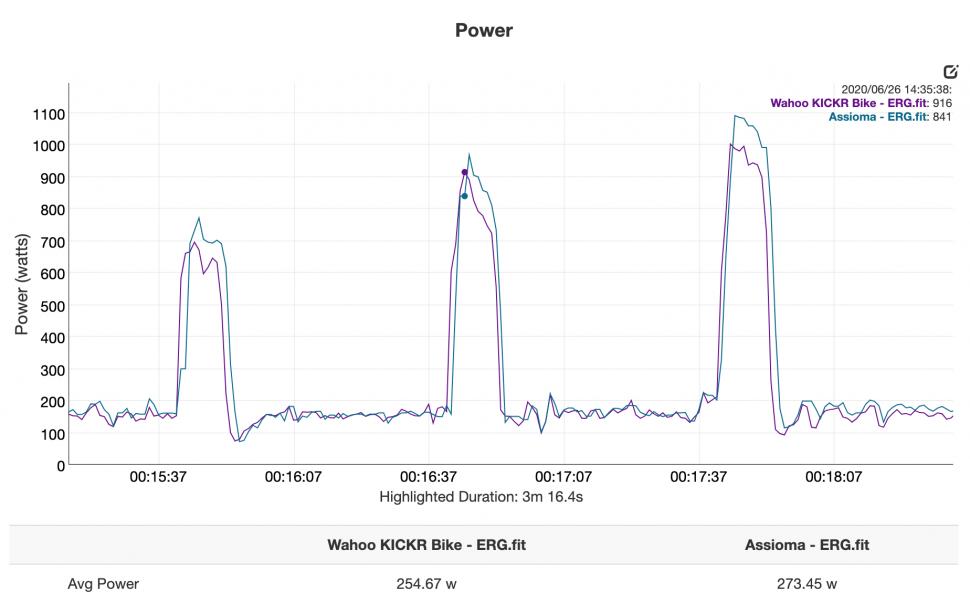
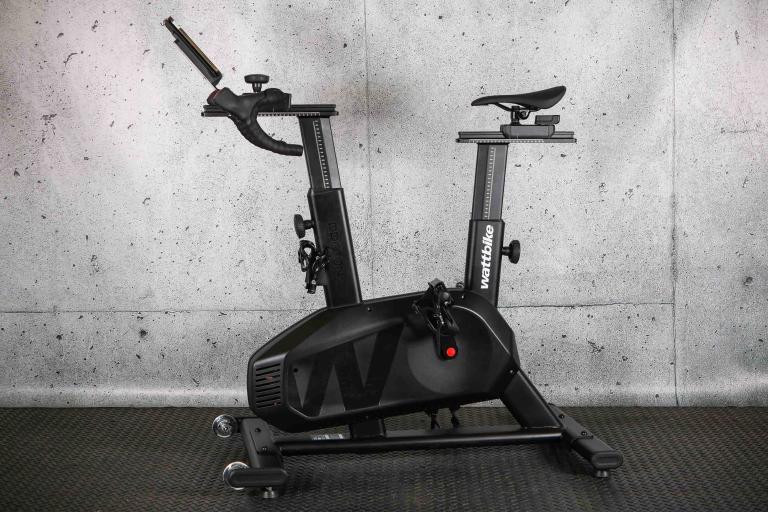
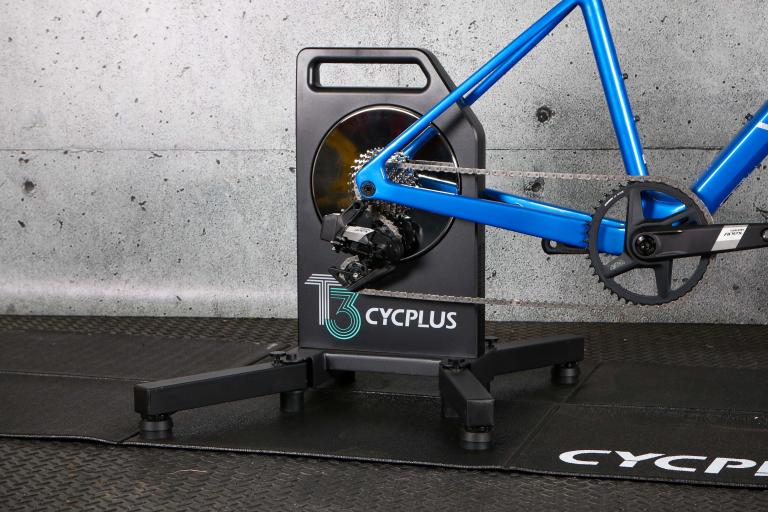
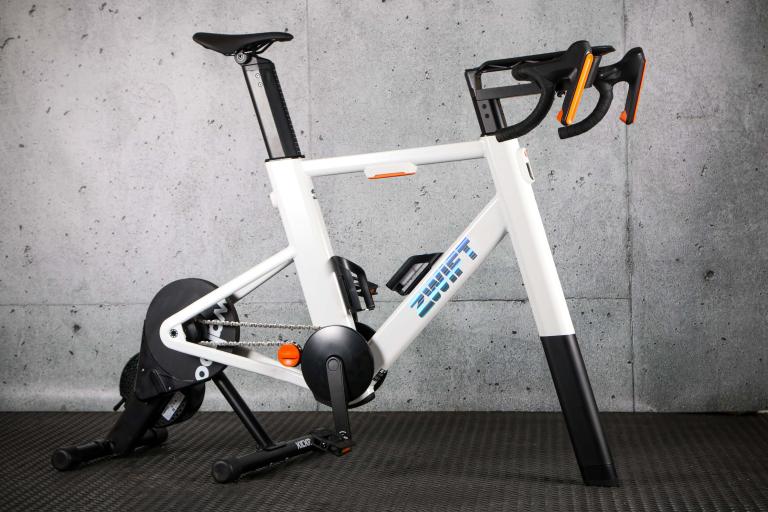

Add new comment
12 comments
Got a new Kickr a couple of months ago- if riding not in erg mode, there is a very significant spike in resistance when changing up a gear- wattage spikes by as much as a 100w or even more for a few seconds.
Wahoo support say this is normal- if you are maintaining the same cadence you need to "accelerate" up to the hihger speed represented by the hihger gear and this requires the extra power.
However, it doesn't feel like a normal gear change on the road- anyone else get this?
I've had mine for several months now and it's done 1300miles. It is very quiet, highly adjustable, with great set up options - I'm a big fan. My one issue is that it has blunted my power figures for racing on zwift compared to all previous trainers (Tacx Neo2, Tacx Flux S, and bike mounted stages and Quarq power meters). I was therefore interested in your comparison to power pedals which showed similar trends. I wonder how Wahoo dealt with factoring in worse power transmission efficiency via the belt drive system when quoting 1% accuracy or is that simply at the flywheel end, explaining why pedals and spider-based systems give slightly higher numbers. Not a huge issue I appreciate but it probably has negated months of perceived gains through training. Interested in any tech comments
I've currently got a Tacx Neo v1, which I love, but when that goes kaput I'll seriously consider one of these new trainers.
However, after Garmin's customer service own-goal with regards the lack of repair options for the Neo, the one I definitely will shy away from will be the Garmin/Tacx bike.
My main problem with the kickr bike is the width of the 'top tube'. It's much wider than the top tube on a normal bike and this, for me, means that thigh rub is an issue. I'd love to take some of the features of the kickr bike and mix them with the physical structure of the stages bike
If you already have a good DD trainer like the Kickr would you say this is worth the upgrade?
Looks great, but is it as aero as other trainers?
you could swap the bars out for some aero ones
i generally wear a skinsuit anyway
It's all about the marginal gains.
More aero, but they removed the mudguard and pannier fixing points
It better be aero at 42kg's!!!
Sounds like there's extra vertical compliance, at least.